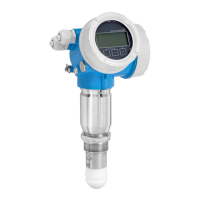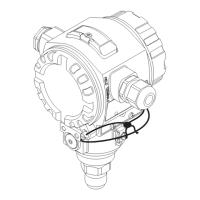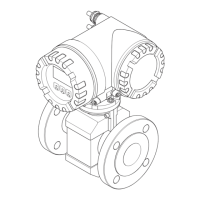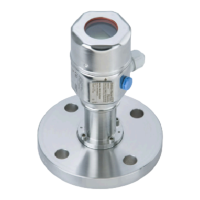Micropilot FMR62 Proof testing
Endress+Hauser 23
The test is to be considered successful if the current values in step 2 are within the
required level of accuracy.
NOTICE
The device has failed the proof test if the current value at a specific level deviates by >
± 2% from the expected value.
99% of dangerous, undetected failures are detected using this test (proof test coverage
(PTC) = 0.99).
‣
For troubleshooting measures, see the Operating Instructions.
L
CAUTION
Re-installation in the original tank
SIL mode is not activated.
‣
SIL mode must be reactivated (according to "Device configuration for safety-related
applications").
‣
If an interference echo mapping was performed in the test tank, it is necessary
following installation in the original tank to carry out another interference echo
mapping that is valid for that tank.
6.3 Test sequence C
Preparatory steps
1. Deactivate SIL mode. To do so, in the operating menu select "Setup → Advanced setup
→ Deactivate SIL/WHG → Reset write protection" and enter the appropriate locking
code (WHG: 7450; SIL: 7452; SIL and WHG: 7454).
The SIL mode is deactivated.
2. Connect a suitable measuring device (recommended accuracy better than ±0.1 mA)
to the current output.
3. Determine the safety setting (point level or range monitoring).
Procedure for point level monitoring
1. Perform device self-check. For this, in the operating menu "Expert → Sensor → Sensor
diagnostics → Start self check" select "Yes".
2. After performing the test, read the result in the "Expert→ Sensor → Sensor
diagnostics → Result self check" parameter.
This part of the test has been passed only when "OK" is displayed here.
3. Simulate a level directly below (MAX monitoring) or directly above (MIN monitoring)
the point level to be monitored. For this, in the operating menu "Diagnostics →
Simulation → Assign measurement variable" select "Level" and enter the value in the
"Diagnostics → Simulation → Process variable value" parameter.
4. Read the output current, record it and assess for accuracy.
5. Simulate a level directly above (MAX monitoring) or directly below (MIN monitoring)
the point level to be monitored.
6. Read the output current, record it and assess for accuracy.
The test is to be considered successful if the current in step 4 does not result in activation
of the safety function but the current in step 6 does.
If the "Expert" menu group is selected, a prompt for the access code appears on the
display. If an access code was defined under "Setup → Advanced setup → Define access
code" this code must be entered here. If no access code was defined, the prompt can be
acknowledged by pressing the "E" key.
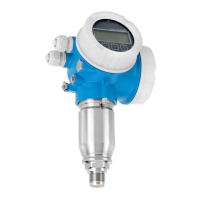
